Written by Paul D. Race for
 , ,  , and , and  |
|
5-String Banjo Buyers' Guide - from Riverboat Music(tm) The Five-String banjo is unquestionably the most popular kind of banjo. What sets it apart from Four-String banjos - popular in early Jazz and in Celtic bands - is a high-pitched drone string that is seldom fretted, and usually adds a sort of twinkle to most playing patterns. You can play Celtic music on a Five-String - many players have, including the great Tommy Makem, but the fifth string makes it hard to play Jazz. Conversely, there are several popular styles of American music that can only be played properly on a Five-String banjo, Bluegrass being among the chief. So, if you like Bluegrass, "Old-Timey," or Folk-style banjo, you want a Five-String. Fortunately for you, over the banjo's lifetime, the Five-String banjo has been by far the most popular kind, giving you access to many choices of new instruments and even more choices of used ones.
Compared to the size of the body, the banjo has the longest neck, of any stringed instrument. Banjos with really heavy bodies, like high-end Bluegrass banjos (see below) put even more strain on the neck. As you'll see when you start shopping, the Five-String banjo has many potential "bells and whistles" that add volume, sustain, and weight. But a banjo with all the best "bells and whistles" and a mediocre neck is worth far less to musicians than a stripped-down banjo with a perfect neck. So as we get into the description of the "bells and whistles," don't let that distract you from the fact that there are totally "stripped-down" banjos that cost far more - and are worth far more - than a lot of banjos that have every possible add-on. It's all about the neck.
| ||||||||||||||||
| The simplest example is a "backless" banjo. This example is one of the best - a Deering-built Vega Senator In case you like the sound and not the price, the Deering Goodtime (baseline model) | 
|
| The next example is a wooden-pot banjo with a resonator bolted on. A resonator does increase volume, because it reflects the sound from the back of the head (instead of it all going into your stomach). But the main reason so many low-end banjos have resonators is that first-time buyers think the banjo looks naked without them. That said, if you want a backless banjo and can't find one you can afford consider getting something like this and "losing" the resonator permanently.
This example is a Gold Tone CC-100R Cripple Creek | 
|
| The next example is a "pop-top" banjo, so called because the one-piece metal pot/resonator flange/tone ring resembles a pop bottle top. You'll never see these without a resonator, because that's the only thing that keeps them from being a deadly medieval weapon. This example is a Dean BW3 You seldom see really bad banjos with this construction, but you also seldom see really good banjos with this construction. Note: Many "pop-top" banjos claim to have a tone ring, a name usually given to a big brass piece added to a wood pot banjo. They are louder and brighter than wooden-pot banjos without tone rings, but I still thank that's false advertising. | 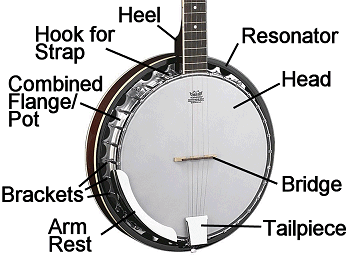
|
| The next example shows Deering's successful attempt to crush the higher-end pop-top banjos - the Deering Boston | 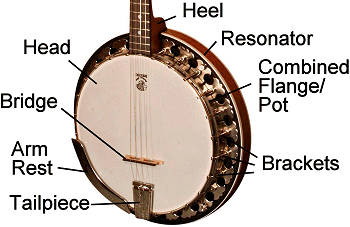
|
| The next example is included only because the transparent head of the thing allows you to see a feature that is usually invisible - a real tone ring. This particular banjo is a relatively new import that's getting mixed reviews from banjo players, so I won't necessarily recommend it at this time. But the photo sort of shows the big brass ring that is sitting between the drum head and the wooden pot. These add volume, sustain, and weight. It also shows a one-piece resonator flange, which bolts to the pot and holds the resonator on. This is sometimes erroneously called a "tone ring" by makers of cheap banjos. And it does add a little more volume and sustain than the little brackets that hold the resonator onto the cheapest resonator banjo. But it's not a tone ring by any worthwhile definition.
| 
|
| Our final example is example shows a top-of-the line with pretty much every feature you could ever want - the Deering Golden Wreath By the way, though you can't see them, the dual coordinator rods are very important on a banjo with this much extra weight - they help stabilize the neck. Occasionally you'll see an imported banjo with all of these features and a single coordinator rod. Trust me, you don't need the hassle. | 
|
Now that you've seen most of the various possible combinations of bells and whistles here's one more reminder that it's easier and cheaper for third-world manufacturers to put a tone ring or whatever on a banjo than it is to build a high-quality neck. Within many lines, more features just mean more features, not necessarily better playing.
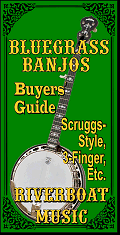
Bluegrass:
consider bells and whistles - If you are a big fan of Bluegrass music specifically, you will eventually want a banjo with more volume and sustain. So a "pop-top" resonator banjo might be your best first model - they are loud without being too expensive.If you stick with it, you may eventually want to migrate toward a banjo with a wooden pot, resonator, real tone ring, and one-piece resonator flange - in other words, all the bells and whistles. Click on the link to the right to see our Bluegrass Banjo buyer's guide.
"Folk," "Old-Timey," "Frailing," and "Clawhammer": consider a Backless Banjo - On the other hand, you may prefer styles that have a strumming component (such as "frailing" and the style currently being called "clawhammer"). If that's the case, you may want to start - and to stick with - a backless banjo. If you can't find a backless banjo in your price range, and you can track down a cheap, but playable resonator banjo with a wood pot, just "lose" the resonator.
By the way, if you start investing "upscale" backless banjos, you may encounter two other options:
 "Frailing scoops" - this is a relatively new accommodation for people who use the back of their fingernails to play everything but the high G string. Within the last few decades, some folks who used those techniques decided they prefer the sound if they strum the banjo partway up the neck, instead of over the head. But those silly high frets they never used got in the way. So they experimented with carving out a "scoop" near the base of the neck - something the original folks who used those playing styles never did. Eventually, they talked certain banjo makers into adding a scoop to most or all of their backless banjos. The real old-time banjo players they're imitating never needed this and neither do you.
"Frailing scoops" - this is a relatively new accommodation for people who use the back of their fingernails to play everything but the high G string. Within the last few decades, some folks who used those techniques decided they prefer the sound if they strum the banjo partway up the neck, instead of over the head. But those silly high frets they never used got in the way. So they experimented with carving out a "scoop" near the base of the neck - something the original folks who used those playing styles never did. Eventually, they talked certain banjo makers into adding a scoop to most or all of their backless banjos. The real old-time banjo players they're imitating never needed this and neither do you. 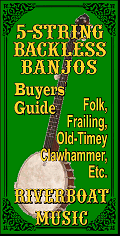 But if a banjo comes that way, don't be afraid of it.
But if a banjo comes that way, don't be afraid of it.
Note: We have just added a page that tells more about backless banjos and shows some examples for sale online. If you're thinking that's what you need, or you would just like to see what's available, click on the green box to the right.
Again, all you need to start out is an Five-String with a good neck, so don't let all of the options scare you off. These are just guidelines and suggestions.
Travel, Short Arms, Backpacking, or Child, consider a Short-Scale Banjo - If you have short arms, travel a lot, or plan to backpack the Appalachian Trail, you might want to consider a "Short-Scale" banjo. Several vendors have reissued an old format called the A-scale banjo, which is three
 frets shorter than a standard 5-string but plays much the same. It is great for students or travel, and the better models sound much like their full-length brethren. They're about the same length as a Martin Backpacker, if that helps, although they are wider.
frets shorter than a standard 5-string but plays much the same. It is great for students or travel, and the better models sound much like their full-length brethren. They're about the same length as a Martin Backpacker, if that helps, although they are wider.
In addition, even smaller banjos are available, banjos you can squeeze into your carry-on luggage or sleeping bag if you want, although you may wind up playing in the key of C instead of G.
Then banjo started to become less popular, and most student Five-String manufacturing moved to China. It's possible that in ten year this will no longer be true, but up until now (2015), the big problem with Chinese-made banjos has been quality control - no matter what brand you buy, you run about a 50% chance of getting what you paid for your first time out.
Regarding US-made banjos, there are a few. Gibson is still making banjos, of course, but they're not cheap. Deering's "Good Time" banjos focus on having great necks and relatively few "bells and whistles," which keeps the cost down for exceptionally playable instruments for the price range. Certain other US manufacturers get their parts, or even fully-built banjos from other countries and do final assembly or setup here, so you have to read between the lines to know if you're getting a US-made banjo or not. Still, knowing that someone has actually looked at the thing between the factory and the retailer helps.
Once you start looking at used banjos, you may get overwhelmed. Remember, the neck is first; everything else is worthless without a good neck. I've seen 60-year old stripped-down cheap Harmony banjos I'd take anywhere, and 10-year old "juiced-up" "name-brand" imported banjos that are nothing more than wall decorations.
For tips on shopping the used market, check out the "CreekDontRise.com" article Evaluating Used Guitars. Most of that information applies to banjos a well.
Finally, if you do wind up settling for a relatively inexpensive Chinese import, be absolutely certain that you have a person who knows banjos inside and out check it out the first thing you get it, and set it up for you. Most of the low ratings these things accumulate are from folks who got a damaged or badly made unit and didn't realize it until after the return period was over. On the other hand, most of the high ratings they get are from first-timers who like the fact that it's shiny. In off brand Chinese imports, you have about a 40% chance of getting a good instrument on your first try. In "name brand" Chinese imports you run about a 60% chance of getting a good instrument on your first try. Either way, you need the thing checked out as soon as it arrives.
In the meantime, I also recommend checking out the CreekDontRise.com article Setting Up Acoustic Guitars and Other Fretted Instruments - This is something you'll have to learn regardless of where you get your instrument.
 By the way, I've just bought my third Goodtime. They've all been backless, since I have a 20-pound resonator/tone ring banjo to use for Bluegrass-style picking. In the process, I discovered that every time Deering makes a bit of an improvement in their line, more and more people adopt them for semi-professional and even professional use. So the users ask for more, and Deering delivers more. By now, Deering's Goodtime has quite blurred the line between "student" and professional. Their Artisan line (which is replacing the Classic line) sounds and looks like a classic old banjo, except that it's more playable than any but the best preserved, and requires far less maintenance.
By the way, I've just bought my third Goodtime. They've all been backless, since I have a 20-pound resonator/tone ring banjo to use for Bluegrass-style picking. In the process, I discovered that every time Deering makes a bit of an improvement in their line, more and more people adopt them for semi-professional and even professional use. So the users ask for more, and Deering delivers more. By now, Deering's Goodtime has quite blurred the line between "student" and professional. Their Artisan line (which is replacing the Classic line) sounds and looks like a classic old banjo, except that it's more playable than any but the best preserved, and requires far less maintenance.
There is one exception - the tone-ring, resonator Artisan plays like anything, and would work good for amateur Bluegrass or Bluegrass jams, but if you want a banjo for professional Bluegrass, you'll eventually want something with two coordinating rods and a heavier tone ring. Something like Deering's least expensive professional banjo, the Boston.
But for all purposes, a Deering Goodtime will meet your needs better than an import, even a fairly "juiced" import.
Our article comparing the three open-back Goodtimes I have owned is here.
Please check back for updates, and contact us with any questions, corrections, additions, or reader responses.
|
How To Help Our Site for Free: If you find our tips, explanations, and recommendations helpful when picking out a product, Please Bookmark This Page and come back through it when you're ready to order. It costs you nothing, and we never see who placed the order, so you don't have to worry about us pestering you with followup e-mails or some such. But it helps us know what pages you find useful, and it helps our advertisers know who to support.
And that, in turn, helps us provide more useful resources. Thank you! |
Note about Suppliers: While we try to help you get the instruments and other products you want by recommending suppliers with a good record of customer service, all transactions between you and the supplier you chose are governed by the published policies on the supplier's web site. So please print off any order confirmation screens and save copies of invoices, etc., so you can contact the appropriate supplier or invoke the product warranty should any problems occur.*
Note about Ordering Musical Instruments Online: Buy only from folks with a reasonable return policy and be sure to have any musical instrument you ordered online checked over by a professional as soon as you receive it. Every musical instrument has the potential for being damaged in shipment, even if the box looks fine when you get it. In addition, musical instruments shipped across the Pacific have a very high percentage of manufacturing defects. If you look at online reviews, a surprising percentage of the one-star reviews say something like "By the time I realized it was damaged (or had a critical manufacturing defect), the period for returns had run out, so now I'm stuck with a useless piece of . . . . " Yes, the manufacturer should have better quality control, and the store should pack things better. But in the end, you are responsible for making certain that an instrument or product will serve your needs while you still have time to return it.
Consider Buying Used: Before you spend $2000 on an instrument that will be worth $800 once you get it home, check out the used market for that sort of instrument in your area. Depending on where you live, or what kind of instrument you're looking for, it may not be an option. But if you can get a used professional instrument for the same price as a new student instrument, it is often worth taking the risk. Especially if you have a knowledgeable friend who can go along and check it out for you. In fact, many of our pages include links to articles on how to shop for used instruments of various types. However, we recognize that many folks have limited access to good used instruments, and everyone needs to see what is available in the various price ranges. So we do list, when possible, live links to real vendors with a good return policy, in case they're your best choice for getting what you want. Again, once you buy something, your satisfaction is between you and the seller.
Note about Availability and Pricing: Although I try to keep an eye on things and to recommend products that are reasonably available, the musical instrument market does fluctuate, and any product on this page may change price or become unavailable without prior notice. If you "click through" to see details on a product, and nothing happens at all, or you are routed to a supplier's home page, please let me know and I will remove the product from the online listing until I can find a replacement or another supplier.
*Here's an irony: every year, I receive about a dozen complaints from folks who have never been to my sites before, angry that a deal between that person and a vendor or manufacturer I recommend went south (in their opinion). They "googled" the product, saw my recommendation or review, then e-mailed me to tell me they were going to sue me or report me to the Better Business Bureau for personally ripping them off by recommending a product they had bought from someone else. Ninety-nine times out of a hundred, the problem is really because the customer didn't read the whole ad, or ordered the wrong thing, or threw away his paperwork and doesn't know where he bought it from, etc. I'm always polite, and sometimes I can even help them get things straightened out with the vendor, but it's not, technically, my problem.
Click here to return to the text.
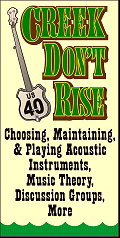



|
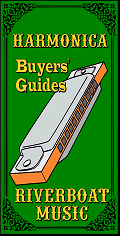
| Visit related pages and affiliated sites: | ||||||
| - Music - | ||||||

|
 |
 |

|

|

|
|

|

|

|

|

|

|
|
| - Trains and Hobbies - | ||||||
 |

|

|  |
 |

|
|
| - Christmas Memories and Collectibles - | ||||||
 |

|
 |

|
 |

|
|
| - Family Activities and Crafts - | ||||||
 |

|

|

|

|

|
|